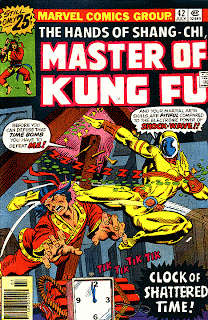 The Modern Masters series from Twomorrows Press has counfounded me a bit, starting with making Alan Davis their first book. I think that Davis is really, really good, but not the artist that I think that I would have started the series with. Still, that is a moot point. What concerns us today is the 12th volume in the series: Michael Golden.
The Modern Masters series from Twomorrows Press has counfounded me a bit, starting with making Alan Davis their first book. I think that Davis is really, really good, but not the artist that I think that I would have started the series with. Still, that is a moot point. What concerns us today is the 12th volume in the series: Michael Golden.I was there in the beginning of Golden's career, and was immediately taken by the fact that, within a few months it seemed, DC comics in 1977 has lucked on to two very striking talents: Marshall Rogers and Michael Golden. The early stories by Golden, one stand alone issue of Batman, and the Batman family stuff in the dollar comics were eye-catching in the extreme. There was a two page Man-Bat splash, as well as a two page Demon spread that were more dynamic than almost anything published at DC over the last decade. After years of fairly pedestrian work, DC would discover two greats right before the now infamous Implosion. Looking through this book should have been a real joy.
 I emphasize should have been. Oh, the book has been put together with care and love by John Morrow and Eric Nolen-Weathington, the reproduction is very nice, the interview covering a great scope of Golden's career. The problem is mine really. I was so dis-satisfied with the reality that there is no deeper to Golden's artwork. To paraphrase, to him, its a job and one that he took to pay the rent and to try to do the best he could. he sort of drifted into the work from doing vans and skateboards, without a great love of the medium, and was pushed into going to NYC to visit Marvel and DC.
I emphasize should have been. Oh, the book has been put together with care and love by John Morrow and Eric Nolen-Weathington, the reproduction is very nice, the interview covering a great scope of Golden's career. The problem is mine really. I was so dis-satisfied with the reality that there is no deeper to Golden's artwork. To paraphrase, to him, its a job and one that he took to pay the rent and to try to do the best he could. he sort of drifted into the work from doing vans and skateboards, without a great love of the medium, and was pushed into going to NYC to visit Marvel and DC.Feh, thats what i have to say. Reading the interview and reading his rather non-commital answers to questions about the Nam, or the single greatest annual story since Kirby drew the monumental FF Annual #1, Avengers Annual #10, leave me flat. I want there to be some more emotion, some more reaction on his part. after all, I found his art to be so interesting, so dynamic that I want to believe that there is something more there than craft.
And its clear that there isn't.
And its my own fault as a fan really, to have put my expectations on the artist and the art, and now I find myself reading it with a different sense of how the art came about. I have one Golden original, from a clever little Batman/Talia/Ra's Al Ghul story from the Batman Spectacular issue also featuring art by Rogers and Nasser. And yes, the art betrays the slightly muddied lighting sources that plagued Golden's work in the first year or two, but otherwise is a fun little piece of art. And I never saw any sweat stains or deep pencil grooves in the bristol.
And now I know why. Because it was easy.
































